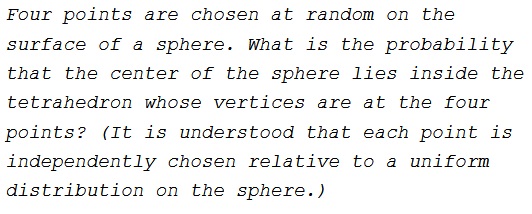Four Random Points on a Sphere
Problem

Solution 1
Four points $A,B,C,D$ define a system of barycentric coordinates in the space such that every point $E$ can be uniquely expressed as a linear combination with real coefficients
$E=wA+xB+yC+zD,$ $w+x+y+z=1.$
Point $E$ lies in the interior of the tetrahedron $ABCD$ iff all the coefficients are positive. Thus, if $O$ stands for the origin and serves as the center of the sphere, the problem inquires of the probability that $O=wA+xB+yC+zD,$ with $w+x+y+z=1$ and $w,x,y,z\gt 0.$
Let's fix one of the points and denote it $P.$ The other three points will be denoted $P_1,P_2,P_3$ and will each be selected in two steps. First we select three random diameters $Q_{i1}Q_{i2},$ $i=1,2,3.$ Next, we randomly pick one of the endpoints of each of the three diameters and take them for $P_1,P_2,P_3,$ respectively. There are $2^3=8$ ways to perform the second step. So that the three diameters define $8$ tetrahedra. Observe that since, for $i=1,2,3,$ $Q_{i1}+Q_{i2}=2O,$ the coefficients in $O=wP+xP_1+yP_2+zP_3,$ change signs every time one of the $P's$ is replaced with another end point of the corresponding diameter. It follows that, disregarding the cases of zero probability like that one of the faces of the tetrahedron passes through the origin, only four one out of $8$ tetrahedra, all the coefficients have the same sign and can be chosen positive. Thus, the probability of including the origin is $\displaystyle \frac{1}{8}$ for any three random diameters. It follows that the thought probability is $\displaystyle \frac{1}{8}.$
Solution 2
Let's associate with every point $X$ on the sphere $S,$ the semisphere $[X)$ that has that point as its center. We claim the following:
A tetrahedron $ABCD$ inscribed into a sphere contains the center of the sphere in its interior iff the four hemispheres $[P_1),$ $[P_2),$ $[P_3),$ $[P_4)$ cover the sphere entirely.
Let $O$ be the center of the sphere and, for a point $X$ on the sphere, let $]X$ be the half-space bounded by a plane through $O$ that does not include $[X).$ If point $P$ on the sphere is not covered by any of the four semispheres $[P_i),$ $i=1,2,3,4,$ it lies in the interior of the $4-sided$ cone with the apex at $O:$ $\displaystyle P\in \cap_{i=1}^4\;]P_i.$ This means that all the angles $POP_i,$ $i=1,2,3,4$ are obtuse, implying that $P_i\in\;]P,$ $i=1,2,3,4.$ In other words, the tetrahedron $P_1P_2P_3P_4\subset ]P$ and, therefore, does not contain $O.$
This means that if $O\in P_1P_2P_3P_4$ then $\displaystyle S\subset\cup_{i=1}^4\;[P_i).$ We need to prove the converse.
Assume $O\notin P_1P_2P_3P_4.$ There exists a plane $\pi$ that separates $P_1,$ $P_2,$ $P_3,$ $P_4$ and $O$. The perpendicular from $O$ to $\pi$ crosses the sphere in two points; let $P$ be the farthest of the two from $\pi.$ Then all angles $POP_i$ are obtuse, so that $P\notin\cup_1^4[P_i).$
The answer $\displaystyle \frac{1}{8}$ is now retrieved from the formula $1-2^{n}(n^2-n+2)$ (with $n=4)$ as the probability of $n$ hemispheres covering the whole of the sphere.
Acknowledgment
This is problem A-6 from the 1992 Putnam mathematical Competition. Solutions have been published in American Mathematical Monthly (v 100, n 8, 755-767) by the team of L. F. Klosinski, G. L. Alexanderson, L. C. Larson. Solution 1 is a paraphrase of one of these. I am grateful to Mike Lawler for bringing this problem to my attention.
A remark by Kostas Theodoros Rekoumis helped me break a mental block that derailed completing this page for quite a while.
- What Is Probability?
- Intuitive Probability
- Probability Problems
- Sample Spaces and Random Variables
- Probabilities
- Conditional Probability
- Dependent and Independent Events
- Algebra of Random Variables
- Expectation
- Probability Generating Functions
- Probability of Two Integers Being Coprime
- Random Walks
- Probabilistic Method
- Probability Paradoxes
- Symmetry Principle in Probability
- Non-transitive Dice
![]()
|Contact| |Front page| |Contents| |Algebra|
Copyright © 1996-2018 Alexander Bogomolny73580915
